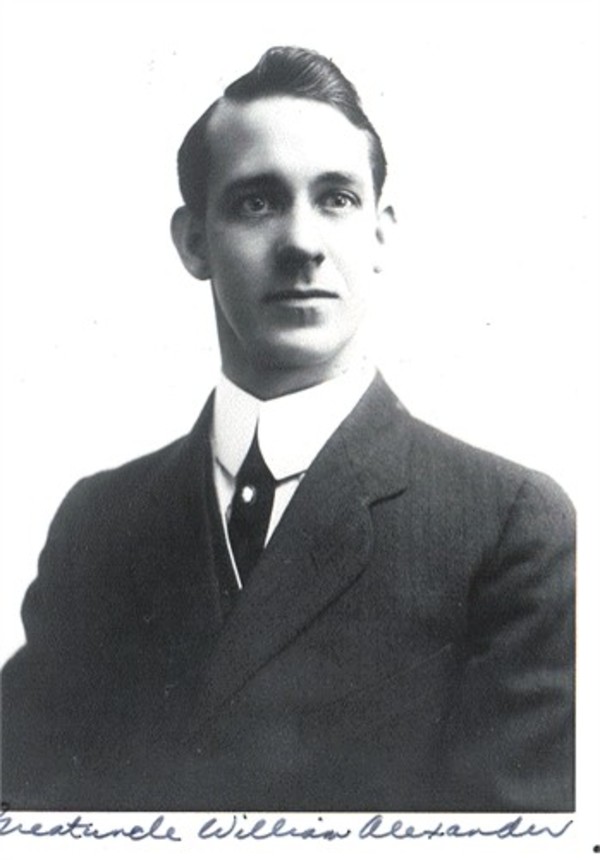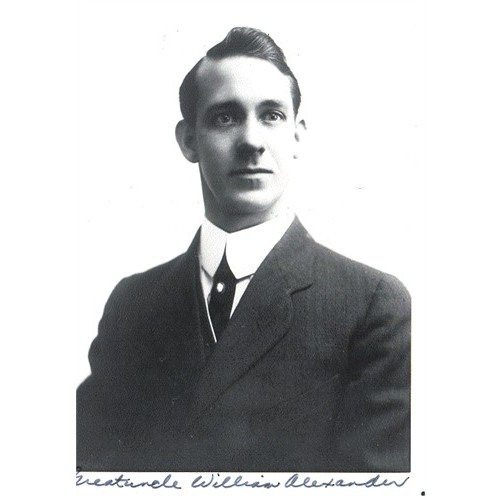
Source: Link
ALEXANDER, WILLIAM, soldier; b. 18 Sept. 1880 in London, England; executed 18 Oct. 1917 near Houdain, France.
Bill Alexander’s family origins and early life are obscure. He joined the British army and served for eight years with the King’s Royal Rifle Corps. Soon after, he came to Canada and found a job in Winnipeg with the Auto Tire and Vulcanizing Company, which in 1914 sent him to help establish a branch in Calgary. At the outbreak of war in August, Alexander hastened to enlist in the 103rd Regiment (Calgary Rifles), and on 24 September, at Valcartier, Que., he was attested in the 10th Infantry Battalion, Canadian Expeditionary Force. As an old soldier, he was immediately appointed colour-sergeant for one of the battalion’s eight companies, though he reverted to sergeant when the unit was reorganized into four companies.
Alexander went overseas with the 10th and shared in its battles, from second Ypres (1915) to Vimy Ridge (1917). In November 1915 he was appointed acting company sergeant-major but he reverted to sergeant at his own request two months later. The “Fighting Tenth” had a particularly harsh time in June 1916 during the Canadian struggle to regain Mount Sorrel, Belgium, entering the line three times after absorbing heavy losses. Later, officers would remember that Alexander had done well. His reward was promotion to company quartermaster sergeant, the second-senior NCO in the company.
Henceforth, much of his life was spent in the rear of the line. On 28 October, after the battalion had withdrawn from the Somme in France, he began his first leave in England. He returned infected with syphilis and did not rejoin the 10th until 7 April 1917, just before it shared the attack on Vimy Ridge. Once again, severe casualties led to his promotion to acting company sergeant-major, on the 21st. Three days later he was thrown from his ration limber and injured his left knee. “I do not consider that he was to blame,” wrote his commanding officer, Lieutenant-Colonel Daniel Mowat Ormond. After hospitalization and convalescence Alexander returned to his unit on 10 August. At dawn five days later, the 10th went over the top in the assault on Hill 70 and took its objective at high cost. On the 16th the battalion was ordered to pass over the hill and take the German positions in the Chalk Quarry. It was a desperate struggle and, by its end, the 10th had won more medals than any other Canadian battalion earned in a single battle during World War I.
Amidst so much heroism, there were two sorry tales. An officer, new to the unit, had panicked in the assault on the quarry and almost cost the battalion its success. And CQMS Alexander, assigned to lead a platoon in support of this assault, had vanished by zero-hour, leaving it to a corporal to take his men forward. He was later found at Les Brebis, behind the line. He claimed that he had been blown over by a shell but he bore no marks; he had not, he admitted, reported the matter. He was charged with desertion on active service and brought before a field general court martial on 26 September.
An obvious defence plea would have been for the reduced charge of absence without leave. If one was entered, the court was not moved. Within a day it had heard the evidence, rendered a verdict, and pronounced the designated sentence: death. Alexander’s fate depended on the commander-in-chief of the British Expeditionary Force, Sir Douglas Haig, who confirmed the sentence on 15 October. Haig must have been influenced by the views of the officer who knew the accused best, Lieutenant-Colonel Ormond, who considered Alexander’s work, except at Mount Sorrel, “indifferent.” “It is my opinion that he deliberately endeavoured to avoid the particular service in the charge against him.” Alexander learned of Haig’s decision on the night of 17 October. Despite the efforts of Canon Frederick George Scott*, the senior chaplain of the 1st Canadian Division, the sentence was carried out at 5:57 the next morning, on a foggy hillside near Houdain, by a firing squad drawn from the 2nd Canadian Infantry Brigade.
Of the 25 Canadians executed during the war, Alexander was the most senior and the longest serving. His fate has fuelled intermittent controversy over the use of the death penalty in World War I. “I can hardly believe, that, for the first offence of desertion, that they were justified in passing that sentence,” wrote his elder brother, Archibald M. Alexander, when he finally learned the truth about how Bill had died. “May the Lord have mercy on the man who judged him if he was wrong.”
NA, RG 9, III, 4072, folder 73; RG 24, file 649-A-6909; 2357, file HQS 1822-1; RG 150, Acc. 1992–93/166, file 20726. D. G. Dancocks, Gallant Canadians: the story of the Tenth Canadian Infantry Battalion, 1914–1919 (Calgary, 1990). Directories, Calgary, 1914; Winnipeg, 1912. Desmond Morton, “The supreme penalty: Canadian deaths by firing squad in the First World War,” Queen’s Quarterly (Kingston, Ont.), 79 (1972): 345–52; When your number’s up: the Canadian soldier in the First World War (Toronto, 1993). Nicholson, CEF, 286–91. F. G. Scott, The Great War as I saw it (2nd ed., Vancouver, 1934).
Cite This Article
Desmond Morton, “ALEXANDER, WILLIAM,” in Dictionary of Canadian Biography, vol. 14, University of Toronto/Université Laval, 2003–, accessed November 28, 2024, http://www.biographi.ca/en/bio/alexander_william_1880_1917_14E.html.
The citation above shows the format for footnotes and endnotes according to the Chicago manual of style (16th edition). Information to be used in other citation formats:
| Permalink: | http://www.biographi.ca/en/bio/alexander_william_1880_1917_14E.html |
| Author of Article: | Desmond Morton |
| Title of Article: | ALEXANDER, WILLIAM |
| Publication Name: | Dictionary of Canadian Biography, vol. 14 |
| Publisher: | University of Toronto/Université Laval |
| Year of publication: | 1998 |
| Year of revision: | 1998 |
| Access Date: | November 28, 2024 |



